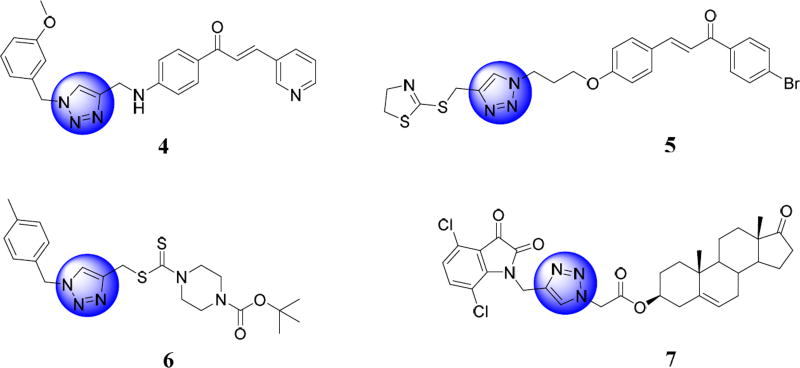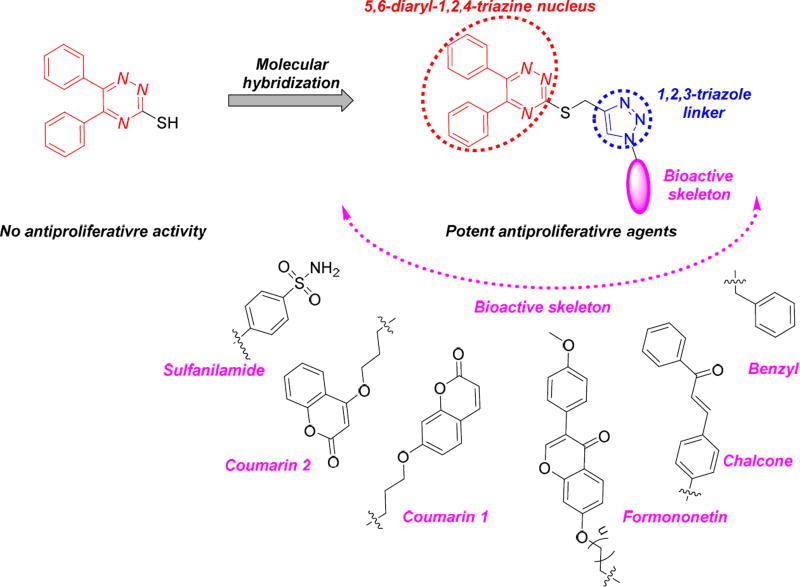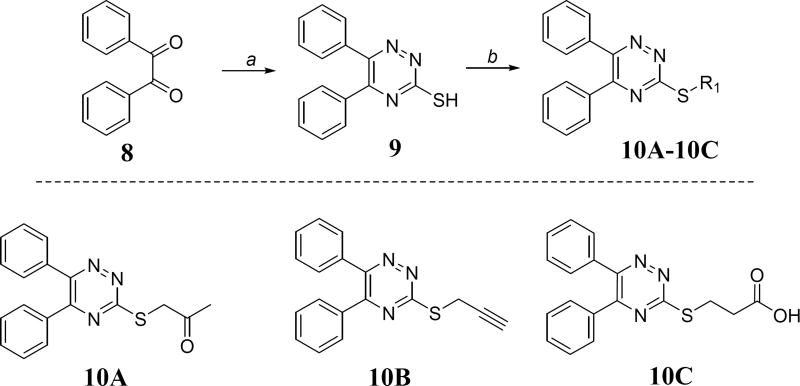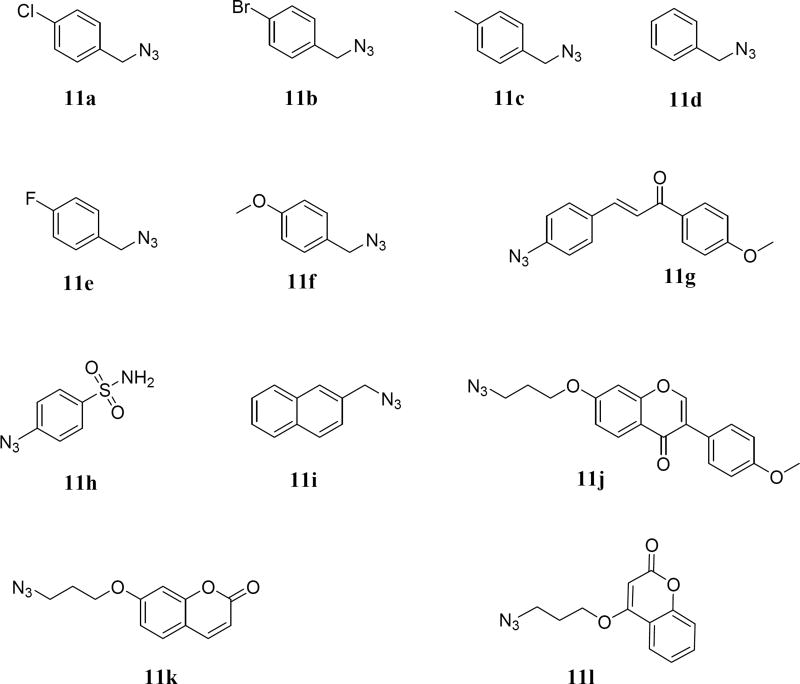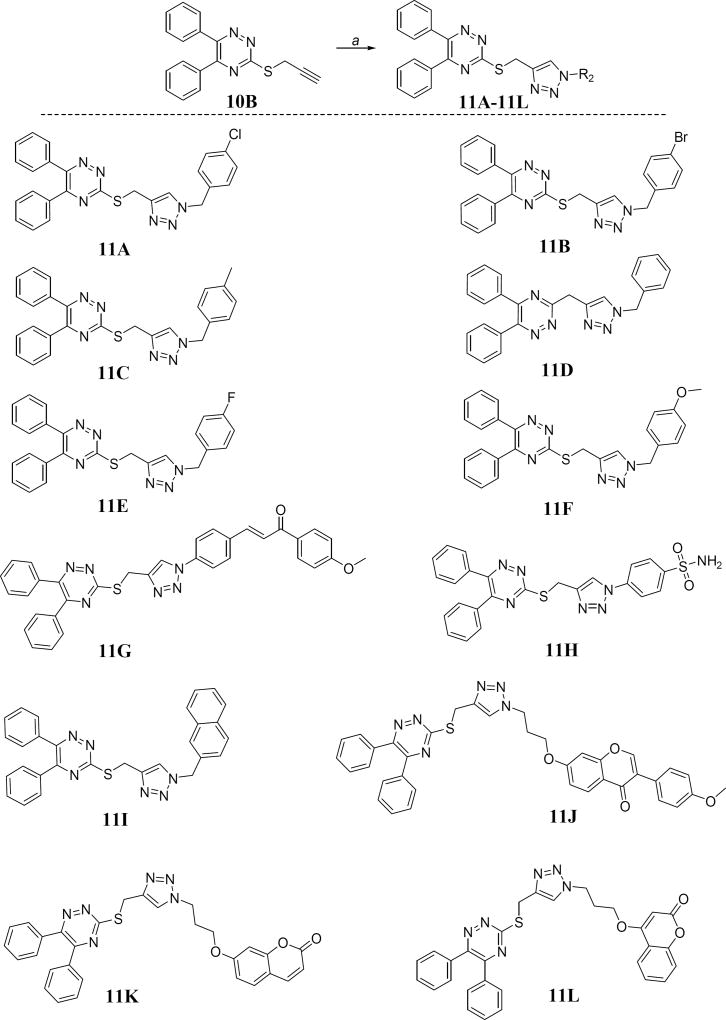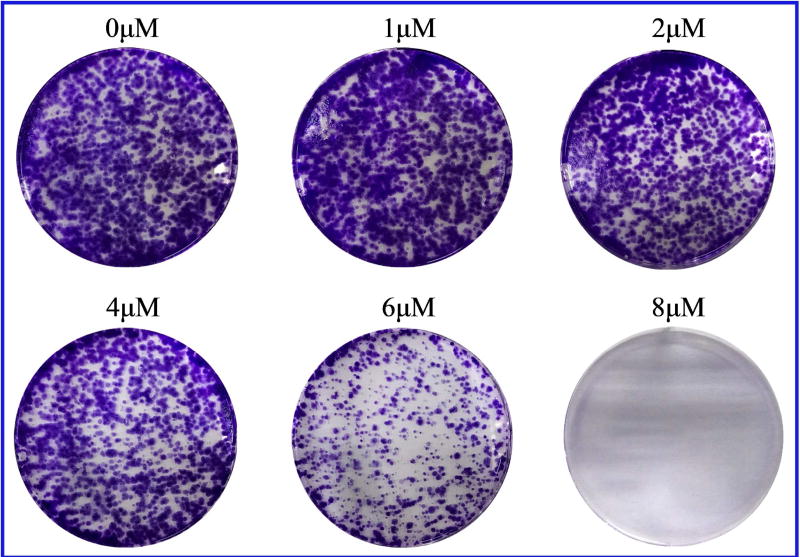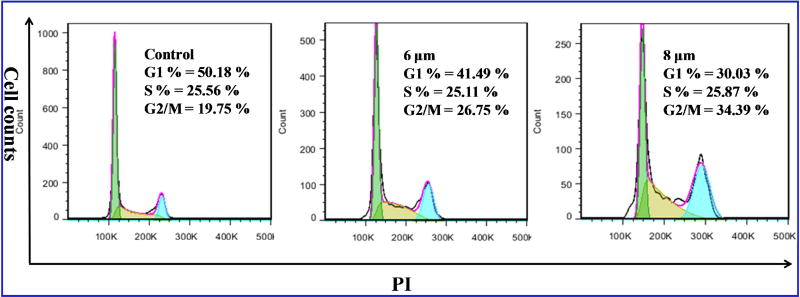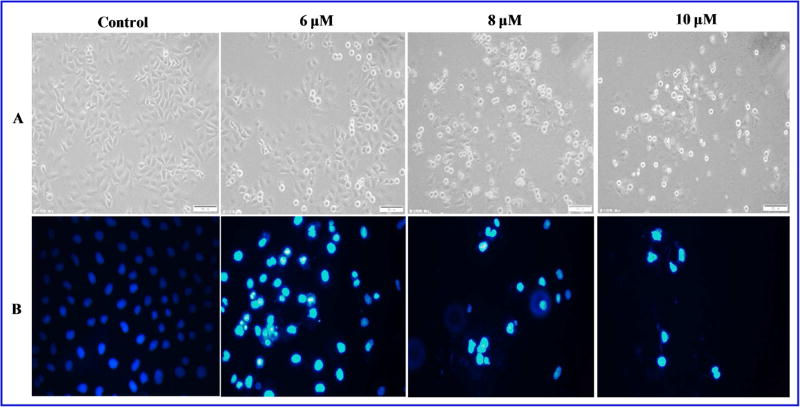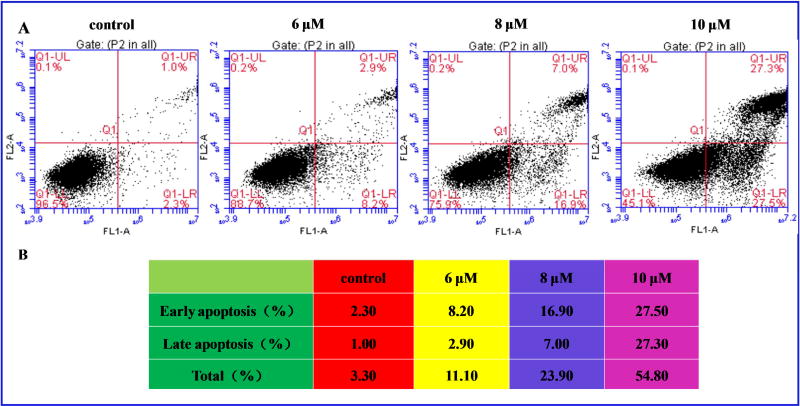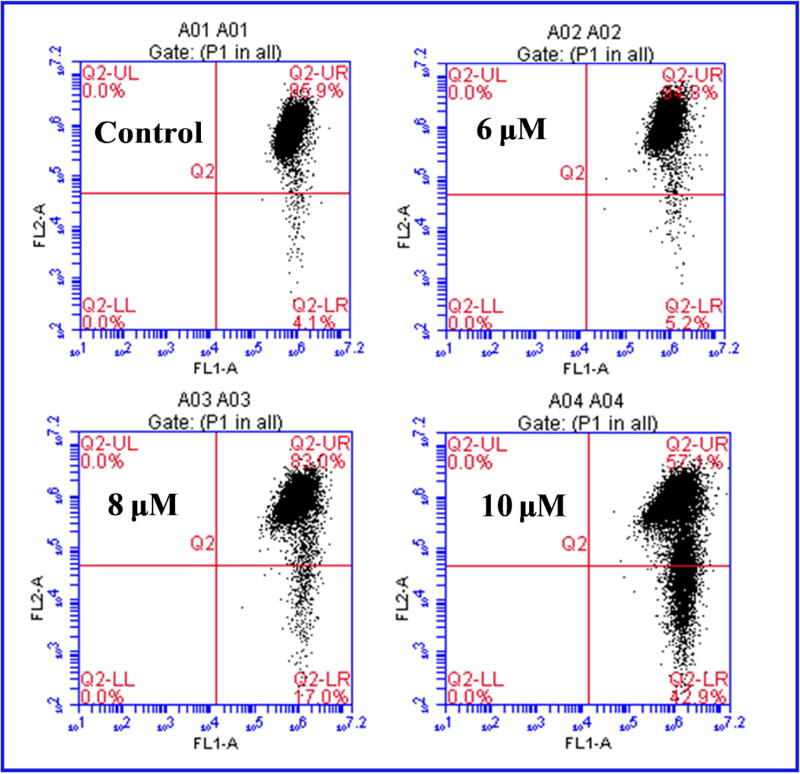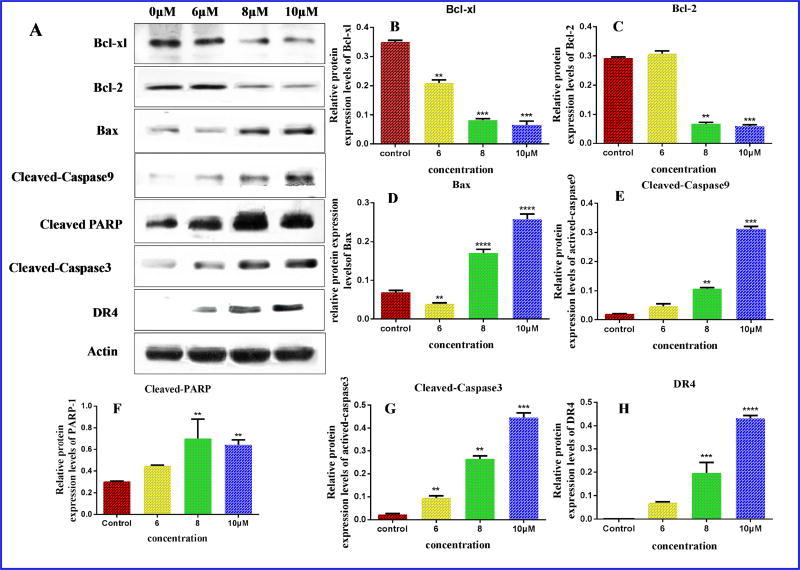Abstract
A series of 5,6-diaryl-1,2,4-triazines hybrids bearing a 1,2,3-triazole linker were synthesized by molecular hybridization strategy and evaluated for antiproliferative activity against three selected cancer cell lines (MGC-803, EC-109 and PC-3). The first structure-activity relationship (SAR) for these 5,6-diaryl-1,2,4-triazines is explored in this report with evaluation of 15 variants of the structural class. Among these chemical derivatives, 3-(((1-(4-fluorobenzyl)-1H-1,2,3-triazol-4-yl)methyl)thio)-5,6-diphenyl-1,2,4-triazine (11E) showed the more potent inhibitory effect against three cell lines than 5-Fu. Cellular mechanism studies in MGC-803 cells elucidated 11E inhibited colony formation and arrested cell cycle at G2/M phase. Furthermore, compound 11E caused morphological changes, decreased mitochondrial membrane potential, and induced apoptosis through the apoptosis-related proteins in MGC-803 cells. It was the first time, to our knowledge, that 5,6-diaryl-1,2,4-triazines bearing a 1,2,3-triazole linker were used as potential apoptosis inducers.
Keywords: 5,6-diaryl-1,2,4-triazines; molecular hybridization strategy; morphological changes; apoptosis; apoptosis-related proteins
Graphical abstract
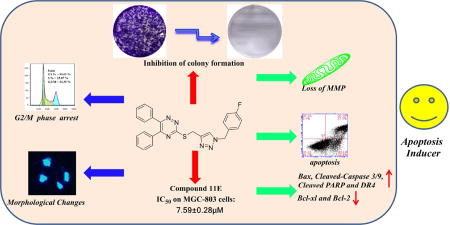
1. Introduction
5,6-Diaryl-1,2,4-triazine, an important heterocyclic skeleton, has been reported to exhibit a variety of biological activities [1–7]. 2-((5,6-diphenyl-1,2,4-triazin-3-yl)thio)-N-arylacetamide derivative 1 with strong electron-withdrawing nitro group on the arylacetamide moiety exhibited potent α-glucosidase inhibitory activity (IC50 = 12.46 ± 0.13 µM) [8]. 5,6-diaryl-1,2,4-triazine bearing 3-morpholinoethylamine moiety 2 displayed a promising antithrombotic profile in vivo, which demonstrated less ulcerogenicity in rats as compared to aspirin [9]. 1,2,4-triazine derivative 3 was synthesized and screened for inhibition of cyclooxygenases (COX-1 and COX-2) with anti-oxidant activity based on a cellular assay using human whole blood and lipoxygenase [10]. However, few studies investigated 5,6-diaryl-1,2,4-triazine moiety as a promising anticancer scaffold (Fig. 1).
Fig. 1.
Bioactive 5,6-diaryl-1,2,4-triazine derivatives.
1,2,3-triazole, a privileged scaffold in drug discovery, displayed a wide array of biological activities as antibacterial, anti-fungal, anti-HIV, anti-allergic, anti-tubercular and anti-inflammatory agents [11–14]. Recently, our group have reported four series of 1,2,3-triazole derivatives as potential antitumor agents (Fig. 2): 1,2,3-triazole-chalcone hybrid 4 inhibited the proliferation of SK-N-SH cancer cells by inducing apoptosis and arresting the cell cycle at the G1 phase [15]; the novel 1,2,3-triazole-chalcone 5 bearing a 4,5-dihydrothiazole showed the potent activity with an IC50 value of 8.16 µM against neuroendocrine cancer cells [16]; 1,2,3-triazole-dithiocarbamate based selective lysine specific demethylase 1 inactivator 6 inhibited gastric cancer cell apoptosis, invasion, and migration [17]; the steroidal hybrid 7 arrested cell cycle at G2/M phase, induced apoptosis accompanied with decrease of mitochondrial membrane potential [18].
Fig. 2.
1,2,3-triazole derivatives as antiproliferative agents.
Molecular hybridization strategy is a useful concept in drug design and development based on the combination of pharmacophoric moieties of different bioactive substances to produce a new hybrid with improved affinity and efficacy, when compared to the parent drugs [19, 20]. These above interesting findings and our continuous quest to identify more potent anticancer agents led to the molecular hybridization of 5,6-diaryl-1,2,4-triazine and bioactive scaffolds by a 1,2,3-triazole linker to integrate them in one molecular platform to generate a new hybrid with a potential antiproliferative activity.
As shown in Fig. 3, a molecular hybridization strategy based on the structures of a 5,6-diaryl-1,2,4-triazine and a 1,2,3-triazole yielded a scaffold which has three parts: (i) a 5,6-diaryl-1,2,4-triazine scaffold as a central core, (ii) a 1,2,3-triazole as a linker to combine different antiproliferative active skeletons, and (iii) a variety of reported antiproliferative skeletons (benzyl moiety, chalcone, formononetin, coumarin, sulfanilamide) [21–23]. To the best of our knowledge, there have been no literature reports regarding 5,6-diaryl-1,2,4-triazine hybrids bearing a 1,2,3-triazole linker as antiproliferative agents so far. These findings also encouraged us to investigate the potential synergistic effect of 1,2,3-triazole and 5,6-diaryl-1,2,4-triazine scaffolds.
Fig. 3.
Rational molecular hybridization design.
2. Results and discussion
2.1. Chemistry
To explore the potential synergistic effect of 1,2,3-triazole and 5,6-diaryl-1,2,4-triazine scaffolds, 5,6-diaryl-1,2,4-triazine derivatives without triazole moiety 10A–10C were synthesized in Scheme 1. Condensation of commercially available compound 8 with thiosemicarbazide in acetic acid at 120 °C for 3.5 h provided the 5,6-diphenyl-1,2,4-triazine-3-thiol 9 [24], which was then reacted with different bromides (1-bromopropan-2-one, 3-bromoprop-1-yne, and 3-bromopropanoic acid) in the presence of triethylamine as base to obtain compound 10A-10C.
Scheme 1.
Reagents and conditions: (a) AcOH, thiosemicarbazide, reflux, 3.5 h; (b) Et3N, bromides (1-bromopropan-2-one or 3-bromoprop-1-yne, or 3-bromopropanoic acid), Acetone, reflux.
In order to obtain the target 5,6-diaryl-1,2,4-triazines hybrids bearing a 1,2,3-triazole linker, various azide derivatives 11a–11l were used to synthesize the target compounds by click reaction. The structures of azide derivatives 11a–11l in this work were shown in Scheme 2. The synthetic methods and structure confirmation of azide derivatives 11a–11l were described in the Supporting Information.
Scheme 2.
Azide derivatives 11a–11l in this work.
As shown in Scheme 3, 5,6-diaryl-1,2,4-triazine-triazole derivatives 11A–11L were achieved by reaction of compound 10B with various azides [25, 26] using sodium ascorbate and CuSO4.5H2O in THF at room temperature. The structures of all the new synthesized compounds 10A–10C and 11A–11L were characterized by 1H NMR、 13C NMR and HRMS.
Scheme 3.
Reagents and conditions: (a) Sodium ascorbate, CuSO4.5H2O, azides 11a–11l, THF/H2O, r.t.
2.2. Antiproliferative activity
In continuation with our efforts toward the identification of novel derivatives with anticancer potential, we evaluated the antiproliferative activity of 5,6-diaryl-1,2,4-triazine derivatives 10A–10C and 5,6-diaryl-1,2,4-triazine-triazole hybrids 11A–11L using the MTT assay. 1,2,3-triazole derivatives have reported as potent antiproliferative agents against PC-3 cells, MGC-803 cells and EC-109 cells [27]. All the target compounds in this work contained a 1,2,3-triazole moiety. Therefore, these three cancer cell lines (MGC-803, EC-109, PC-3) were selected to evaluate their antiproliferative activity. When some 1,2,3-triazole derivatives were reported as potent antiproliferative agents, 5-fluorouracil (5-FU) was selected as the control [27]. Therefore, 5-Fu was also used as the reference drug in this MTT assay.
The antiproliferative activity results against all three cancer cells for the candidate compounds were shown in Table 1. In order to investigate the effect of the inhibitory activity of 1,2,3-triazole, non-1,2,3-triazole-5,6-diphenyl-1,2,4-triazines 10A–10C and 1,2,3-triazole-5,6-diphenyl-1,2,4-triazines 11A–11L were examined for their antiproliferative activity. Removal of the 1,2,3-triazole was clearly detrimental for the inhibitory activity against the three cancer cell lines, as shown by compounds 10A–10C. The introduction of 1,2,3-triazole scaffold resulted in an improvement of inhibitory activity. Especially, compound 11E showed the more potent inhibitory effect against three cell lines than 5-Fu. This result suggested that 1,2,3-triazole moiety may play a synergistic role in determining activity.
Table 1.
Antiproliferative activity of target derivatives.
| Compound | IC50 (µM)a | ||
|---|---|---|---|
|
|
|||
| MGC-803 | EC-109 | PC-3 | |
| 10A | >100 | >100 | >100 |
| 10B | >100 | >100 | >100 |
| 10C | >100 | >100 | >100 |
| 11A | 13.23±0.99 | 24.24±1.16 | 14.66±0.09 |
| 11B | >100 | >100 | 22.00±3.39 |
| 11C | 34.75±0.51 | 12.42±0.04 | 22.63±2.02 |
| 11D | 11.35±0.97 | 11.05±1.56 | 15.60±1.09 |
| 11E | 7.59±0.28 | 19.12±1.11 | 10.63±0.28 |
| 11F | 22.71±2.86 | 28.41±0.11 | 27.51±0.39 |
| 11G | 36.67±4.69 | >100 | >100 |
| 11H | >100 | >100 | >100 |
| 11I | >100 | >100 | >100 |
| 11J | >100 | >100 | 10.23±0.77 |
| 11K | >100 | >100 | 92.34±8.27 |
| 11L | >100 | >100 | 57.77±4.36 |
| 5-FU | 9.79±0.17 | 56.20±5.48 | 12.87±1.20 |
Antiproliferative activity was assayed by exposure for 48 h to substances and expressed as concentration required to inhibit tumor cell proliferation by 50% (IC50). Data are presented as the means±SDs from the doseresponse curves of three independent experiments.
In order to complete the structure activity relationship study, a series of 5,6-diphenyl-1,2,4-triazine-1,2,3-triazole hybrids were prepared and evaluated for their antiproliferative activity. With the exception of compounds 11A–11F, all the compounds bearing a 1,2,3-triazole moiety exhibited potential antiproliferative activity. To determine whether the substituents on the phenyl ring have an effect on the inhibitory activity, compounds with various groups on the phenyl ring were compared with activity. We found that the substitution on the phenyl ring was important for the activity showing an over 4-fold activity loss, when the fluoro group was replaced with methyl group (compounds 11E vs. 11C). In addition, the size of halogen group on the phenyl ring may affected the antiproliferative activity. Replacement of the bromine atom of compound 11B and chlorine atom of compound 11A with a fluorine atom 11E led to an increase of the activity.
Furthermore, compounds with a chalcone scaffold (11G), a sulfanilamide scaffold (11H), a naphthyl scaffold (11I), a formononetin scaffold (11J) and coumarin scaffolds (11K–11L) were synthesized to explore the effect of bioactive scaffolds for their antiproliferative activity. Compound bearing a chalcone scaffold 11G displayed antiproliferative activity against MGC-803 cells with an IC50 value of 36.67 µM. However, compounds possessing a sulfanilamide group 11H or a naphthyl group 11I were unactive against three cancer cell lines. We also found that the type of coumarin ring affected the activity comparing compound 11K with compound 11L. In addition, there is an interesting discovery that 5,6-diphenyl-1,2,4-triazine-1,2,3-triazole hybrid bearing a formononetin moiety 11J exhibited more potent cytotoxicity against PC-3 cancer cells than 5-Fu. However, compound 11J displayed no significant antiproliferative activity against MGC-803 cells and EC-109 cells indicating that compound 11J had good selectivity among different cancer cells.
Compound 11E displayed the potent antiproliferative activity against MGC-803 cells with an IC50 value of 7.59 µM. Compound 11E was further examined for possible cytotoxicity against GES-1 (normal human gastric epithelial cell line). We found that compound 11E exhibited weak cytotoxicity against GES-1 (31.71±1.24 µM). The results indicated that compound 11E had good selectivity between the selected cancer cell line (MGC-803) and a normal cell line (GES-1).
2.3. Clone assays
Based on the most excellent activity against MGC-803 cells, compound 11E was chosen to perform colony formation to investigate whether 11E could inhibit MGC-803 cells proliferation (Fig. 4). The assay measures the ability of MGC-803 cells to grow and form foci, which represents an indirect estimation of neoplastic transformation [28]. As shown in Fig. 4, MGC-803 cells treated with 11E exhibited fewer and smaller colonies compared to the control, which indicated that compound 11E could significantly inhibit the proliferation of MGC-803 cells in a concentration-dependent manner.
Fig. 4.
Representative images of MGC-803 cells colonies after treatment 11E with various concentrations for a week.
2.4. 11E induces G2/M phase arrest
Targeting the cell cycle of tumor cells has been recognized as a promising strategy for cancer therapy [29]. In this study, compound 11E was chosen to investigate the effect of our designed derivatives on the cell cycle of MGC-803 cells. After treating MGC-803 cells with compound 11E at different concentrations (0 µM, 6 µM, 8 µM) for 48 h, cells were then fixed and stained with PI for flow cytometry analysis. As shown in Fig. 5, compound 11E concentration dependently arrested cell cycle at G2/M phase.
Fig. 5.
Effects of 11E on MGC-803 cell cycle progress for 48 h.
2.5. Morphological changes of MGC-803 cells induced by compound 11E
Morphological changes of cancer cells are always associated with the growth inhibition induced by cytotoxic agents [30]. Inspired by the good inhibition of compound 11E against MGC-803 cells, we then investigated whether compound 11E was able to induce morphological changes. After being incubated with 11E for 48 h at different concentrations (0 µM, 6 µM, 8µM, 10 µM), the morphological changes of MGC-803 cells were recorded using an inverted microscope. As shown in Fig. 6A, significant changes of cell morphology such as rounding up and cell debris were observed, especially at high concentrations. After staining with Hoechst 33258, remarkable nuclear changes including the chromatin condensation, nuclear fragmentation and condensation were also observed (Fig. 6B).
Fig. 6.
(A)The morphological changes of cells were observed under an inverted microscope (magnification, ×400).(B) MGC-803 cells were incubated with indicated concentrations of 1035 for 48 hours and then stained with DAPI. The stained nuclei were then observed under a fluorescentmicroscope (magnification, ×400).
2.6. Apoptosis detection by flow cytometry
The effect of compound 11E on the apoptosis was investigated using the propidium iodide (PI) and Annexin V-FITC biparametric cytofluorimetric analysis. After treatment with different concentrations of compound 11E (0 µM, 6 µM, 8µM, 10 µM) for 48 h, MGC-803 cells were stained with PI and FITC, and then analyzed by the flow cytometry [31]. As illustrated in Fig. 7, compound 11E induced apoptosis of MGC-803 cells in a concentration-dependent manner. Specifically, the percentage of apoptotic cells was about 3.3% for the control group. When treated with high concentration (10 µM) of compound 11E, around 54.8% of apoptosis rate was observed. While the late apoptosis rate of MGC-803 cells was not changed significantly with increasing concentrations.
Fig. 7.
Compound 11E induced apoptosis of MGC-803 cells in a concentration-dependent manner.
2.7. 11E decreased the membrane potential (ΔΨ) of the mitochondria
The decrease of mitochondrial membrane potential through multiple mechanisms including deficiency of oxidizable substrates for the blockage of respiration, the mitochondria, or uncoupling of the inner membrane, followed by cytochrome c release from the mitochondria and expression changes of apoptosis-related proteins (e.g. Bax, Bcl-2, caspase3/9, parp, etc) have been observed during apoptosis process. The remarkable apoptosis induced by compound 11E promoted us to explore whether this compound had an effect on the mitochondrial membrane potential. MGC-803 cells were incubated at the indicated concentrations (0 µM, 6 µM, 8µM, 10 µM) for 48 h, then stained and analyzed by flow cytometry. As shown in Fig. 8, compound 11E caused the mitochondrial membrane potential decrease in a concentration-dependent manner. The percentage of cells at 10 µM was 42.9%, significantly higher than that of the control group (4.1%).
Fig. 8.
MGC-803 cells were treated with vehicle control and various concentrations of 11E (0µM, 6µM, 8µM, and 10µM) for 48 hours. The mitochondria membrane potential was measured by JC-1 dye retention using flow cytometry.
2.8. 11E affected apoptosis-related protein expression
Proteins in Bcl-2 family are key regulators of apoptosis and overexpression of the prominent pro-survival Bcl-2 family members like Bcl-2 and Bcl-xL is a common feature responsible for deregulation of apoptosis in human adenocarcinomas, which make tumor cells resistant to conventional cancer therapeutic agents and thereby resulting in hindrance to cancer cell death [32, 33]. Caspases are cysteine-dependent, aspartate-directed proteases that have been shown to play an important part in the apoptotic cascade of events and caspase 3 and caspase 9 are one of the most important effectors [34]. Poly (ADP ribose) polymerase (PARP), the first caspase substrate identified, is a particularly interesting death substrate, and its cleavage is now recognized as a hallmark of apoptosis [35].
To further investigate the mechanism of apoptosis, western blot analysis was performed in MGC-803 cells by treatment with compound 11E (0µM, 6µM, 8µM, and 10µM) for 48 h. As shown in Fig. 9, treatment of MGC-803 cells with compound 11E resulted in increased expression of Bax, Cleaved-Caspase 9, Cleaved-Caspase 3, Cleaved PARP and DR4 in a concentration-dependent manner. Meanwhile, the expression of apoptotic-related proteins (Bcl-xl and Bcl-2) decreased accordingly. Based on these results, 1,2,3-triazole-5,6-diphenyl-1,2,4-triazine 11E was a potent apoptosis inducer.
Fig. 9.
Expression changes of apoptosis related proteins. (A) compound 11E induced expression changes of apoptosis related proteins in MGC-803 cells; (B–H) Statistical analysis of protein expression levels. The results shown were representative of three independent experiments. **: p < 0.01 verse control, ***: p < 0.001 verse control, ****: p < 0.0001 verse control.
3. Conclusions
Following our previous work, we designed a series of novel 1,2,3-triazole-5,6-diphenyl-1,2,3-triazole derivatives based on molecular hybridization strategy. Majority of hybrids possessed moderate to good growth inhibition against the tested cancer cells. Particularly, compound 11E exhibited more potent antiproliferative activity than well-known antitumor drug 5-Fu against all three cancer cell lines. The preliminary SAR illustrated that 1,2,3-triazole as a reported antitumor scaffold could play potential synergistic effect for 1,2,3-triazole-5,6-diphenyl skeleton. These hybrids in this work might serve as bioactive fragments and lead compounds for developing more potent cytotoxic agents.
The mechanism investigation showed that compound 11E can inhibit the colony formation, halted cell cycle progression at the G2/M phase, induce morphological changes and lead to apoptosis. Further mechanisms of apoptosis indicated that 1,2,3-triazole-5,6-diphenyl-1,2,3-triazole 11E induced MGC-803 cells apoptosis probably through mitochondrial pathway by the decrease of mitochondrial membrane potential and regulation the expression of apoptosis-related proteins. In summary, novel 5,6-diphenyl-1,2,3-triazole derivative bearing a 1,2,3-triazole moiety 11E was a potential apoptosis inducer, which can be used as a lead compound for the development of potent cancer chemotherapeutic agents in the drug discovery process.
4. Experimental section
4.1. General
Reagents and solvents were used without special treatment. Melting points were determined on an X-5 micromelting apparatus and are uncorrected. 1H NMR and 13C NMR spectra were recorded on a Bruker 400 MHz and 100 MHz spectrometer, respectively. High resolution mass spectra (HRMS) of all derivatives were recorded on a Waters Micromass Q-T of Micromass spectrometer by electrospray ionization (ESI).
4.2. General procedure for the synthesis of compounds 10A–10C
5,6-Diphenyl-1,2,4-triazine-3-thiol 9 was prepared by a reported method [1]. To a solution of 9 (0.5 mmol, 1.0 eq) and bromide (0.5 mmol, 1.0 eq) in acetone (10 mL) was added Et3N (0.75 mmol, 1.5 eq), the mixture was refluxed for about 3~4 h. Upon completion, EtOAc and H2O were added. The aqueous layer was extracted with EtOAc for several times; the combined organic layers were washed with H2O for several times to remove the acetone, and then washed with brine, dried over MgSO4 and evaporated to give the products. The residue was purified with column chromatography (hexane: EtOAc = 7:1) to obtain analogue 10A–10C.
4.2.1. 1-((5,6-diphenyl-1,2,4-triazin-3-yl)thio)propan-2-one (10A)
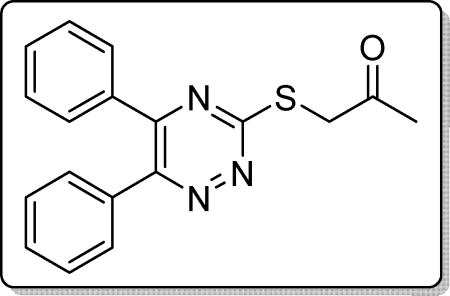
Light yellow solid; Mp:102~104 °C; Yield: 35%. 1H NMR (400 MHz, Acetone-d6) δ 7.75 – 7.27 (m, 10H), 4.32 (s, 2H), 2.35 (s, 3H). 13C NMR (100 MHz, DMSO-d6) δ 201.49, 170.52, 156.47, 155.24, 136.66, 136.40, 131.60, 130.75, 130.33, 130.10, 129.28, 129.23, 41.54, 29.11. HR-MS (ESI): Calcd. C18H16N3OS, [M+H]+m/z: 322.1018, found: 322.1014.
4.2.2. 5,6-diphenyl-3-(prop-2-yn-1-ylthio)-1,2,4-triazine (10B)
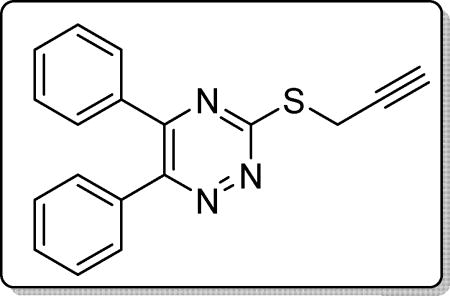
Yellow solid; Mp:96~99 °C; Yield: 63%. 1H NMR (400 MHz, Acetone-d6) δ 7.65 – 7.36 (m, 10H), 4.19 (d, J = 2.6 Hz, 2H), 2.77 (t, J = 2.6 Hz, 1H). 13C NMR (100 MHz, Acetone-d6) δ 169.89, 156.57, 155.45, 136.63, 136.35, 131.68, 130.83, 130.35, 130.16, 129.32, 129.25, 80.13, 72.65, 19.47. HR-MS (ESI): Calcd. C18H14N3S, [M+H]+m/z: 304.0909, found: 304.0908.
4.2.3. 4-((5,6-diphenyl-1,2,4-triazin-3-yl)thio)butanoic acid (10C)
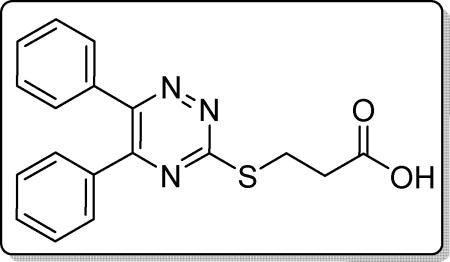
Light yellow solid; Mp:172~174 °C; Yield: 34%. 1H NMR (400 MHz, Acetone-d6) δ 7.56 – 7.13 (m, 10H), 3.44 (dd, J = 9.4, 4.5 Hz, 2H), 2.80 (t, J = 6.9 Hz, 2H). 13C NMR (100 MHz, Acetone-d6) δ 173.04, 171.06, 156.54, 155.20, 136.80, 136.55, 131.58, 130.76, 130.35, 130.09, 129.31, 129.26, 34.39, 26.42. HR-MS (ESI): Calcd. C18H16N3O2S, [M+H]+m/z: 338.0965, found: 338.0963.
4.3. General procedure for the synthesis of compounds 11A–11L
Compound 10B (1 mmol), azide derivatives (1 mmol), CuSO4.5H2O (0.2 mmol) and sodium ascorbate (0.1 mmol) were dissolved in THF/H2O (5 ml/5 ml) to stir for 8 h at room temperature. Upon completion, the precipitated product was filtered off and washed with ethanol to afford the crude product, which was purified with column chromatography (hexane: EtOAc = 9:1) to obtain analogue 11A–11L.
4.3.1. 3-(((1-(4-chlorobenzyl)-1H-1,2,3-triazol-4-yl)methyl)thio)-5,6-diphenyl-1,2,4-triazine (11A)
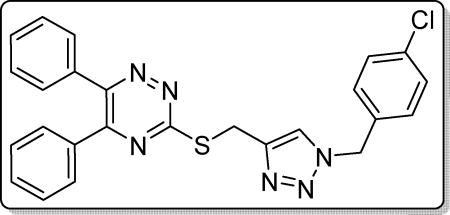
Light yellow solid; Mp:120~122 °C; Yield: 52%. 1H NMR (400 MHz, Acetone-d6) δ 7.97 (s, 1H), 7.60 – 7.28 (m, 14H), 5.58 (s, 2H), 4.66 (s, 2H). 13C NMR (100 MHz, Acetone-d6) δ 170.68, 156.46, 155.21, 144.89, 136.72, 136.40, 135.91, 134.53, 131.64, 130.77, 130.65, 130.34, 130.15, 129.73, 129.34, 129.27, 124.06, 53.41, 26.05. HR-MS (ESI): Calcd. C25H20ClN6S, [M+H]+m/z: 471.1160, found: 471.1159.
4.3.2. 3-(((1-(4-bromobenzyl)-1H-1,2,3-triazol-4-yl)methyl)thio)-5,6-diphenyl-1,2,4-triazine (11B)
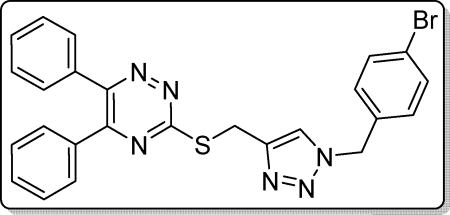
Light yellow solid; Mp:132~134 °C; Yield: 41%. 1H NMR (400 MHz, Acetone-d6) δ 7.97 (s, 1H), 7.60 – 7.32 (m, 12H), 7.24 (d, J = 8.4 Hz, 2H), 5.57 (s, 2H), 4.66 (s, 2H). 13C NMR (100 MHz, Acetone-d6) δ 170.68, 156.47, 155.21, 144.91, 136.71, 136.40, 136.38, 132.73, 131.64, 130.94, 130.77, 130.34, 130.15, 129.35, 129.27, 124.08, 122.65, 53.46, 26.04. HR-MS (ESI): Calcd. C25H20BrN6S, [M+H]+m/z: 515.0657, found: 515.0654.
4.3.3. 3-(((1-(4-methylbenzyl)-1H-1,2,3-triazol-4-yl)methyl)thio)-5,6-diphenyl-1,2,4-triazine (11C)
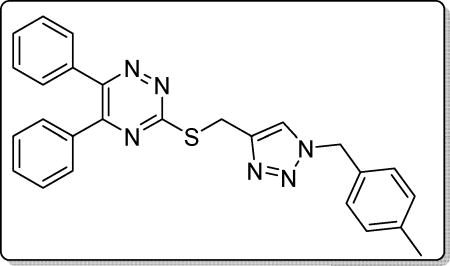
Light yellow solid; Mp:119~121 °C; Yield: 64%. 1H NMR (400 MHz, Acetone-d6) δ 7.90 (s, 1H), 7.60 – 7.32 (m, 10H), 7.15 (dd, J = 22.4, 8.0 Hz, 4H), 5.50 (s, 2H), 4.65 (s, 2H), 2.27 (s, 3H). 13C NMR (100 MHz, Acetone-d6) δ 170.73, 156.46, 155.18, 144.69, 138.82, 136.73, 136.42, 133.95, 131.62, 130.77, 130.34, 130.27, 130.14, 129.33, 129.27, 128.92, 123.81, 54.03, 26.09, 21.11. HR-MS (ESI): Calcd. C26H23N6S, [M+H]+m/z: 451.1708, found: 451.1705.
4.3.4. 3-((1-benzyl-1H-1,2,3-triazol-4-yl)methyl)-5,6-diphenyl-1,2,4-triazine (11D)
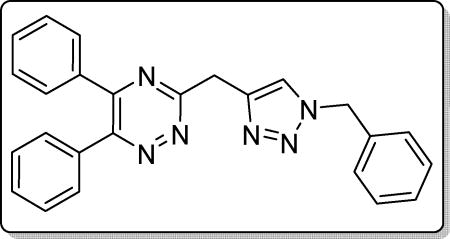
Light yellow solid; Mp:130~132 °C; Yield: 72%. 1H NMR (400 MHz, CDCl3) δ 7.50 (s, 1H), 7.47 – 7.20 (m, 13H), 7.12 (dd, J = 6.6, 2.9 Hz, 2H), 5.38 (s, 2H), 4.57 (s, 2H). 13C NMR (100 MHz, CDCl3) δ 168.68, 154.50, 152.85, 143.41, 133.98, 133.76, 133.38, 129.79, 128.61, 128.31, 128.10, 127.85, 127.47, 127.44, 127.31, 126.79, 121.52, 52.94, 24.38. HR-MS (ESI): Calcd. C25H21N6S, [M+H]+m/z: 437.1549, found: 437.1548.
4.3.5. 3-(((1-(4-fluorobenzyl)-1H-1,2,3-triazol-4-yl)methyl)thio)-5,6-diphenyl-1,2,4-triazine (11E)
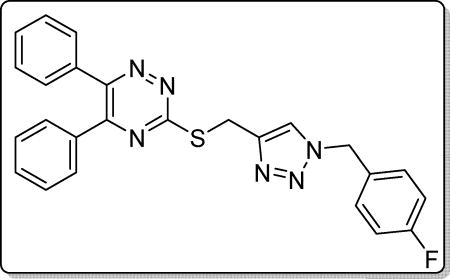
Light yellow solid; Mp:126~128 °C;Yield: 64%. 1H NMR (400 MHz, CDCl3) δ 7.50 (s, 1H), 7.41 (dd, J = 12.7, 5.1 Hz, 4H), 7.37 – 7.32 (m, 2H), 7.31 – 7.27 (m, 2H), 7.24 (d, J = 7.8 Hz, 2H), 7.11 (dd, J = 8.6, 5.2 Hz, 2H), 6.90 (dd, J = 11.9, 5.3 Hz, 2H), 5.33 (s, 2H), 4.56 (s, 2H). 13C NMR (100 MHz, CDCl3) δ 168.80, 162.97, 160.50, 154.67, 153.05, 143.71, 134.13, 130.01, 129.44, 128.91, 128.77, 128.52, 128.25, 127.65, 127.50, 121.64, 115.11, 52.33, 24.52. HR-MS (ESI): Calcd. C25H20FN6S, [M+H]+m/z: 455.1456, found: 455.1454.
4.3.6. 3-(((1-(4-methoxybenzyl)-1H-1,2,3-triazol-4-yl)methyl)thio)-5,6-diphenyl-1,2,4-triazine (11F)
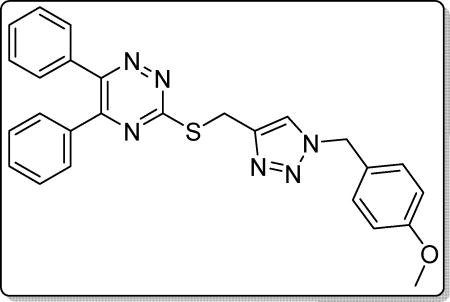
Light yellow solid; Mp:108~111 °C; Yield: 65%. 1H NMR (400 MHz, CDCl3) δ 7.46 (s, 1H), 7.45 – 7.20 (m, 10H), 7.08 (d, J = 8.6 Hz, 2H), 6.75 (d, J = 8.7 Hz, 2H), 5.30 (s, 2H), 4.56 (s, 2H), 3.69 (s, 3H). 13C NMR (100 MHz, CDCl3) δ 168.90, 158.83, 154.65, 153.02, 143.46, 134.18, 133.96, 129.96, 128.79, 128.56, 128.48, 128.28, 127.62, 127.49, 125.55, 121.45, 113.41, 54.28, 52.67, 24.57. HR-MS (ESI): Calcd. C26H23N6OS, [M+H]+m/z: 467.1657, found: 467.1654.
4.3.7. (E)-3-(4-(4-(((5,6-diphenyl-1,2,4-triazin-3-yl)thio)methyl)-1H-1,2,3-triazol-1-yl)phenyl)-1-(4-methoxyphenyl)prop-2-en-1-one (11G)
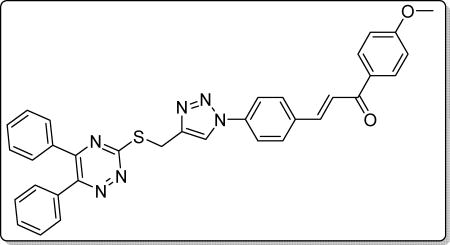
Light yellow solid; Mp:162~164 °C; Yield: 61%. 1H NMR (400 MHz, CDCl3) δ 8.09 (s, 1H), 7.96 (d, J = 8.8 Hz, 2H), 7.68 (d, J = 15.6 Hz, 1H), 7.56 – 7.23 (m, 15H), 6.90 (d, J = 8.8 Hz, 2H), 4.67 (s, 2H), 3.80 (s, 3H). 13C NMR (100 MHz, CDCl3) δ 187.09, 162.66, 140.89, 136.50, 135.90, 134.06, 133.96, 130.32, 130.09, 129.92, 129.68, 129.24, 128.80, 128.55, 128.28, 127.67, 127.64, 127.58, 127.52, 122.62, 120.64, 120.11, 118.38, 112.94, 54.52, 24.45. HR-MS (ESI): Calcd. C34H27N6O2S, [M+H]+m/z: 583.1919, found: 583.1916.
4.3.8. 4-(4-(((5,6-diphenyl-1,2,4-triazin-3-yl)thio)methyl)-1H-1,2,3-triazol-1-yl)benzenesulfonamide (11H)
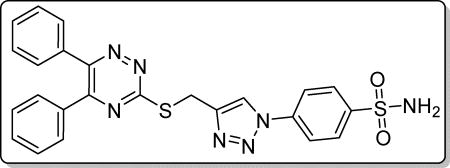
Light yellow solid; Mp:236~238 °C; Yield: 56%. 1H NMR (400 MHz, DMSO-d6) δ 8.85 (s, 1H), 8.06 (d, J = 8.8 Hz, 2H), 7.99 (d, J = 8.8 Hz, 2H), 7.58 – 7.33 (m, 12H), 4.77 (s, 2H). 13C NMR (101 MHz, DMSO-d6) δ 168.94, 155.63, 154.18, 144.64, 143.71, 138.39, 135.08, 134.87, 130.74, 129.60, 129.25, 129.19, 128.36, 128.33, 127.37, 122.02, 120.12, 24.63. HR-MS (ESI): Calcd. C24H20N7O2S2, [M+H]+m/z: 502.1127, found: 502.1120.
4.3.9. 3-(((1-(naphthalen-2-ylmethyl)-1H-1,2,3-triazol-4-yl)methyl)thio)-5,6-diphenyl-1,2,4-triazine (11I)
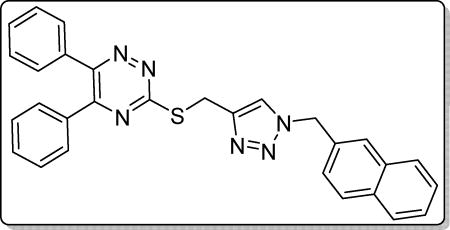
Light yellow solid; Mp:136~138 °C; Yield: 69%. 1H NMR (400 MHz, CDCl3) δ 7.80 – 7.63 (m, 3H), 7.60 (s, 1H), 7.53 (s, 1H), 7.52 – 7.23 (m, 10H), 7.20 (dt, J = 11.5, 3.8 Hz, 3H), 5.54 (s, 2H), 4.57 (s, 2H). 13C NMR (100 MHz, CDCl3) δ 168.85, 154.68, 153.02, 143.70, 134.15, 133.91, 132.15, 132.12, 130.90, 129.94, 128.75, 128.47, 128.27, 128.07, 127.61, 127.45, 126.92, 126.73, 126.29, 125.66, 125.64, 124.24, 121.80, 53.32, 24.57. HR-MS (ESI): Calcd. C29H23N6S, [M+H]+m/z: 487.1709, found: 487.1705.
4.3.10. 7-(3-(4-(((5,6-diphenyl-1,2,4-triazin-3-yl)thio)methyl)-1H-1,2,3-triazol-1-yl)propoxy)-3-(4-methoxyphenyl)-4H-chromen-4-one (11J)
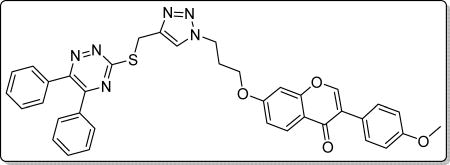
Light yellow solid; Mp:162~164 °C; Yield: 70%. 1H NMR (400 MHz, CDCl3) δ 8.10 (d, J = 8.9 Hz, 1H), 7.81 (s, 1H), 7.63 (s, 1H), 7.42 (dd, J = 14.5, 7.9 Hz, 6H), 7.29 (ddt, J = 21.4, 15.3, 7.7 Hz, 6H), 6.94 – 6.81 (m, 3H), 6.70 (d, J = 2.2 Hz, 1H), 4.59 (s, 2H), 4.46 (t, J = 6.8 Hz, 2H), 3.96 (t, J = 5.7 Hz, 2H), 3.76 (s, 3H), 2.41 – 2.24 (m, 2H). 13C NMR (100 MHz, CDCl3) δ 174.73, 168.86, 161.60, 158.56, 156.76, 154.78, 153.11, 151.09, 143.32, 134.10, 133.88, 130.03, 129.09, 128.79, 128.54, 128.24, 127.66, 127.51, 126.88, 123.85, 123.13, 122.24, 117.66, 113.57, 112.93, 99.73, 63.80, 54.32, 45.93, 28.60, 24.52. HR-MS (ESI): Calcd. C37H31N6O4S, [M+H]+m/z: 655.2128, found: 655.2127.
4.3.11. 7-(3-(4-(((5,6-diphenyl-1,2,4-triazin-3-yl)thio)methyl)-1H-1,2,3-triazol-1-yl)propoxy)-2H-chromen-2-one (11K)
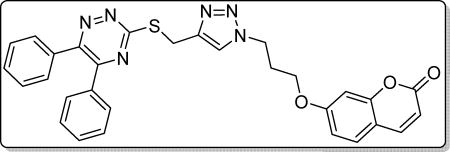
Light yellow solid; Mp:127~129 °C; Yield: 68%. 1H NMR (400 MHz, CDCl3) δ 7.63 (s, 1H), 7.53 (d, J = 9.5 Hz, 1H), 7.48 – 7.23 (m, 11H), 6.75 – 6.63 (m, 2H), 6.17 (d, J = 9.5 Hz, 1H), 4.60 (s, 2H), 4.46 (t, J = 6.8 Hz, 2H), 3.94 (t, J = 5.7 Hz, 2H), 2.33 (p, J = 6.4 Hz, 2H). 13C NMR (100 MHz, CDCl3) δ 168.88, 160.48, 160.01, 154.76, 153.11, 143.39, 142.25, 134.13, 133.91, 130.05, 128.81, 128.55, 128.25, 127.90, 127.67, 127.52, 123.97, 122.17, 112.41, 111.88, 111.47, 100.63, 63.80, 46.00, 28.64, 24.52. HR-MS (ESI): Calcd. C30H25N6O3S, [M+H]+m/z: 549.1712, found: 549.1709.
4.3.12. 4-(3-(4-(((5,6-diphenyl-1,2,4-triazin-3-yl)thio)methyl)-1H-1,2,3-triazol-1-yl)propoxy)-2H-chromen-2-one (11L)
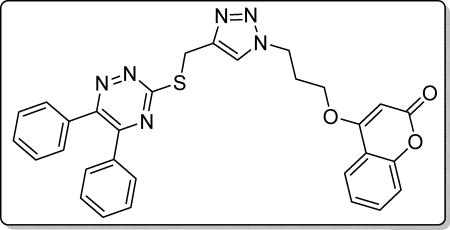
Light yellow solid; Mp:131~132 °C; Yield: 70%. 1H NMR (400 MHz, DMSO) δ 8.17 (s, 1H), 7.67 (ddd, J = 15.6, 8.3, 4.1 Hz, 2H), 7.54 – 7.28 (m, 12H), 5.85 (s, 1H), 4.63 (s, 2H), 4.58 (t, J = 6.7 Hz, 2H), 4.22 (t, J = 5.7 Hz, 2H), 2.43 – 2.26 (m, 2H). 13C NMR (100 MHz, DMSO) δ 169.24, 164.70, 161.53, 155.54, 154.09, 152.68, 142.89, 135.14, 134.89, 132.71, 130.80, 129.64, 129.31, 129.22, 128.43, 128.36, 124.05, 123.77, 122.98, 116.33, 115.05, 90.54, 66.78, 46.69, 28.67, 24.89. HR-MS (ESI): Calcd. C30H25N6O3S, [M+H]+m/z: 549.1715, found: 549.1709.
4.4. Biological testing
The MTT assay, Clonogenicity assay, analysis of cell cycle distribution, Hoechst 33258 staining, detection of apoptosis and mitochondrial membrane potential were carried out following our previously reported method [36]. The Western blot analysis was performed according to the methods previously published [37]. Statistical analysis was performed according to the our reported methods [22]. Therefore, no details are given here.
Supplementary Material
Highlights.
SAR for this 5,6-diaryl-1,2,4-triazine scaffold is explored.
11E inhibited colony formation and arrested cell cycle at G2/M phase.
11E caused morphological changes and decreased mitochondrial membrane potential.
5,6-Diaryl-1,2,4-triazine hybrids were discovered as novel apoptosis inducers.
Acknowledgments
This work was supported by the National Natural Sciences Foundations of China (No. 81673322, 81273393, 81430085, 21372206, and 81172937), Ph.D. Educational Award from Ministry of Education (No. 20134101130001).
Footnotes
Publisher's Disclaimer: This is a PDF file of an unedited manuscript that has been accepted for publication. As a service to our customers we are providing this early version of the manuscript. The manuscript will undergo copyediting, typesetting, and review of the resulting proof before it is published in its final form. Please note that during the production process errors may be discovered which could affect the content, and all legal disclaimers that apply to the journal pertain.
References
- 1.Irannejad H, Amini M, Khodagholi F, Ansari N, Tusi SK, Sharifzadeh M, Shafiee A. Synthesis and in vitro evaluation of novel 1,2,4-triazine derivatives as neuroprotective agents. Bioorg. Med. Chem. 2010;18:4224–4230. doi: 10.1016/j.bmc.2010.04.097. [DOI] [PubMed] [Google Scholar]
- 2.Wang G, Peng Z, Wang J, Li X, Li J. Synthesis, in vitro evaluation and molecular docking studies of novel triazine-triazole derivatives as potential α-glucosidase inhibitors. Eur. J. Med. Chem. 2017;125:423–429. doi: 10.1016/j.ejmech.2016.09.067. [DOI] [PubMed] [Google Scholar]
- 3.Plebanek E, Chevrier F, Roy V, Garenne T, Lecaille F, Warszycki D, Bojarski AJ, Lalmanach G, Agrofoglio LA. Straightforward synthesis of 2,4,6-trisubstituted 1,3,5-triazine compounds targeting cysteine cathepsins K and S. Eur. J. Med. Chem. 2016;121:12–20. doi: 10.1016/j.ejmech.2016.05.009. [DOI] [PubMed] [Google Scholar]
- 4.Singla P, Luxami V, Paul K. Synthesis and in vitro evaluation of novel triazine analogues as anticancer agents and their interaction studies with bovine serum albumin. Eur. J. Med. Chem. 2016;117:59–69. doi: 10.1016/j.ejmech.2016.03.088. [DOI] [PubMed] [Google Scholar]
- 5.Federico S, Ciancetta A, Porta N, Redenti S, Pastorin G, Cacciari B, Klotz KN, Moro S, Spalluto G. 5,7-Disubstituted-[1,2,4]triazolo[1,5-a][1,3,5]triazines as pharmacological tools to explore the antagonist selectivity profiles toward adenosine receptors. Eur. J. Med. Chem. 2016;108:529–541. doi: 10.1016/j.ejmech.2015.12.019. [DOI] [PubMed] [Google Scholar]
- 6.Zheng Z, Pinson J-A, Mountford SJ, Orive S, Schoenwaelder SM, Shackleford D, Powell A, Nelson EM, Hamilton JR, Jackson SP, Jennings IG, Thompson PE. Discovery and antiplatelet activity of a selective PI3Kβ inhibitor (MIPS-9922) Eur. J. Med. Chem. 2016;122:339–351. doi: 10.1016/j.ejmech.2016.06.010. [DOI] [PubMed] [Google Scholar]
- 7.Bera H, Chigurupati S. Recent discovery of non-nucleobase thymidine phosphorylase inhibitors targeting cancer. European Journal of Medicinal Chemistry. 2016;124:992–1003. doi: 10.1016/j.ejmech.2016.10.032. [DOI] [PubMed] [Google Scholar]
- 8.Wang G, Li X, Wang J, Xie Z, Li L, Chen M, Chen S, Peng Y. Synthesis, molecular docking and α-glucosidase inhibition of 2-((5,6-diphenyl-1,2,4-triazin-3-yl)thio)-N-arylacetamides. Bioorg. Med. Chem. Lett. 2017;27:1115–1118. doi: 10.1016/j.bmcl.2017.01.094. [DOI] [PubMed] [Google Scholar]
- 9.Tamboli RS, Giridhar R, Gandhi HP, Kanhed AM, Mande HM, Yadav MR. Design, green synthesis and pharmacological evaluation of novel 5,6-diaryl-1,2,4-triazines bearing 3-morpholinoethylamine moiety as potential antithrombotic agents. J. Enzym. Inhib. Med. Chem. 2016;31:704–713. doi: 10.3109/14756366.2015.1060480. [DOI] [PubMed] [Google Scholar]
- 10.Khoshneviszadeh M, Shahraki O, Khoshneviszadeh M, Foroumadi A, Firuzi O, Edraki N, Nadri H, Moradi A, Shafiee A, Miri R. Structure-based design, synthesis, molecular docking study and biological evaluation of 1,2,4-triazine derivatives acting as COX/15-LOX inhibitors with anti-oxidant activities. J. Enzym. Inhib. Med. Chem. 2016;31:1602–1611. doi: 10.3109/14756366.2016.1158713. [DOI] [PubMed] [Google Scholar]
- 11.Dheer D, Singh V, Shankar R. Medicinal attributes of 1,2,3-triazoles: Current developments. Bioorg. Chem. 2017;71:30–54. doi: 10.1016/j.bioorg.2017.01.010. [DOI] [PubMed] [Google Scholar]
- 12.Silvana R-M, Andrijana M. Recent Trends in 1,2,3-Triazolo-Nucleosides as Promising Anti-Infective and Anticancer Agents. Curr. Med. Chem. 2015;22:1462–1499. doi: 10.2174/0929867322666150227150127. [DOI] [PubMed] [Google Scholar]
- 13.Keri RS, Patil SA, Budagumpi S, Nagaraja BM. Triazole: A Promising Antitubercular Agent. Chem. Biol. Drug Des. 2015;86:410–423. doi: 10.1111/cbdd.12527. [DOI] [PubMed] [Google Scholar]
- 14.Yubo J, Chunxiang K. Recent Advances in the Synthesis of 1-Monosubstituted 1,2,3-Triazoles. Mini-Rev. Med. Chem. 2013;13:713–719. doi: 10.2174/1389557511313050008. [DOI] [PubMed] [Google Scholar]
- 15.Fu D-J, Zhang S-Y, Liu Y-C, Yue X-X, Liu J-J, Song J, Zhao R-H, Li F, Sun H-H, Zhang Y-B, Liu H-M. Design, synthesis and antiproliferative activity studies of 1,2,3-triazole-chalcones. MedChemComm. 2016;7:1664–1671. [Google Scholar]
- 16.Fu DJ, Song J, Zhao RH, Liu YC, Zhang YB, Liu HM. Synthesis of novel antiproliferative 1,2,3-triazole hybrids using the molecular hybridisation approach. J. Chem. Res. 2016 [Google Scholar]
- 17.Zheng YC, Duan YC, Ma JL, Xu RM, Zi X, Lv WL, Wang MM, Ye XW, Zhu S, Mobley D. Triazole-dithiocarbamate based selective lysine specific demethylase 1 (LSD1) inactivators inhibit gastric cancer cell growth, invasion, and migration. J. Med. Chem. 2013;56:8543–8560. doi: 10.1021/jm401002r. [DOI] [PMC free article] [PubMed] [Google Scholar]
- 18.Fu DJ, Zhang L, Song J, Mao RW, Zhao RH, Liu YC, Hou YH, Li JH, Yang JJ, Jin CY. Design and synthesis of formononetin-dithiocarbamate hybrids that inhibit growth and migration of PC-3 cells via MAPK/Wnt signaling pathways. Eur. J. Med. Chem. 2016;127:87. doi: 10.1016/j.ejmech.2016.12.027. [DOI] [PMC free article] [PubMed] [Google Scholar]
- 19.Claudio V-J, Amanda D, Vanderlan da Silva B, Eliezer JB. F. Carlos Alberto Manssour, Molecular Hybridization: A Useful Tool in the Design of New Drug Prototypes. Curr. Med. Chem. 2007;14:1829–1852. doi: 10.2174/092986707781058805. [DOI] [PubMed] [Google Scholar]
- 20.Ng H-L, Chen S, Chew E-H, Chui W-K. Applying the designed multiple ligands approach to inhibit dihydrofolate reductase and thioredoxin reductase for anti-proliferative activity. Eur. J. Med. Chem. 2016;115:63–74. doi: 10.1016/j.ejmech.2016.03.002. [DOI] [PubMed] [Google Scholar]
- 21.Fu D-J, Zhang S-Y, Liu Y-C, Zhang L, Liu J-J, Song J, Zhao R-H, Li F, Sun H-H, Liu H-M, Zhang Y-B. Design, synthesis and antiproliferative activity studies of novel dithiocarbamate–chalcone derivates. Bioorg. Med. Chem. Lett. 2016;26:3918–3922. doi: 10.1016/j.bmcl.2016.07.012. [DOI] [PubMed] [Google Scholar]
- 22.Fu D-J, Zhang L, Song J, Mao R-W, Zhao R-H, Liu Y-C, Hou Y-H, Li J-H, Yang J-J, Jin C-Y, Li P, Zi X-L, Liu H-M, Zhang S-Y, Zhang Y-B. Design and synthesis of formononetin-dithiocarbamate hybrids that inhibit growth and migration of PC-3 cells via MAPK/Wnt signaling pathways. Eur. J. Med. Chem. 2017;127:87–99. doi: 10.1016/j.ejmech.2016.12.027. [DOI] [PMC free article] [PubMed] [Google Scholar]
- 23.Guan AY, Liu CL, Li M, Li ZN, Zhang MX, Zhang H. Synthesis and bioactivity of novel coumarin derivatives. Nat. Prod. Commun. 2011;6:1917–1920. [PubMed] [Google Scholar]
- 24.Khoshneviszadeh M, Ghahremani MH, Foroumadi A, Miri R, Firuzi O, Madadkar-Sobhani A, Edraki N, Parsa M, Shafiee A. Design, synthesis and biological evaluation of novel anti-cytokine 1,2,4-triazine derivatives. Bioorg. Med. Chem. 2013;21:6708–6717. doi: 10.1016/j.bmc.2013.08.009. [DOI] [PubMed] [Google Scholar]
- 25.Ma L-Y, Pang L-P, Wang B, Zhang M, Hu B, Xue D-Q, Shao K-P, Zhang B-L, Liu Y, Zhang E, Liu H-M. Design and synthesis of novel 1,2,3-triazole-pyrimidine hybrids as potential anticancer agents. Eur. J. Med. Chem. 2014;86:368–380. doi: 10.1016/j.ejmech.2014.08.010. [DOI] [PubMed] [Google Scholar]
- 26.Zhang SY, Fu DJ, Yue XX, Liu YC, Song J, Sun HH, Liu HM, Zhang YB. Design, Synthesis and Structure-Activity Relationships of Novel Chalcone-1,2,3-triazole-azole Derivates as Antiproliferative Agents. Molecules. 2016;21:653. doi: 10.3390/molecules21050653. [DOI] [PMC free article] [PubMed] [Google Scholar]
- 27.Yu B, Shi X-J, Ren J-l, Sun X-N, Qi P-P, Fang Y, Ye X-W, Wang M-M, Wang J-W, Zhang E, Yu D-Q, Liu H-M. Efficient construction of novel D-ring modified steroidal dienamides and their cytotoxic activities. Eur. J. Med. Chem. 2013;66:171–179. doi: 10.1016/j.ejmech.2013.05.035. [DOI] [PubMed] [Google Scholar]
- 28.Alimova IN, Liu B, Fan Z, Edgerton SM, Dillon T, Lind SE, Thor AD. Metformin inhibits breast cancer cell growth, colony formation and induces cell cycle arrest in vitro. Cell Cycle. 2009;8:909. doi: 10.4161/cc.8.6.7933. [DOI] [PubMed] [Google Scholar]
- 29.Evan GI, Vousden KH. Proliferation, cell cycle and apoptosis in cancer. Nature. 2001;411:342–348. doi: 10.1038/35077213. [DOI] [PubMed] [Google Scholar]
- 30.Goranov Alexi I, Gulati A, Dephoure N, Takahara T, Maeda T, Gygi Steven P, Manalis S, Amon A. Changes in Cell Morphology Are Coordinated with Cell Growth through the TORC1 Pathway. Curr. Bio. 2013;23:1269–1279. doi: 10.1016/j.cub.2013.05.035. [DOI] [PMC free article] [PubMed] [Google Scholar]
- 31.Wen Z, Zhang Y, Wang X, Zeng X, Hu Z, Liu Y, Xie Y, Liang G, Zhu J, Luo H, Xu B. Novel 3′,5′-diprenylated chalcones inhibited the proliferation of cancer cells in vitro by inducing cell apoptosis and arresting cell cycle phase. Eur. J. Med. Chem. 2017;133:227–239. doi: 10.1016/j.ejmech.2017.03.077. [DOI] [PubMed] [Google Scholar]
- 32.Sharma P, Srinivasa Reddy T, Thummuri D, Senwar KR, Praveen Kumar N, Naidu VGM, Bhargava SK, Shankaraiah N. Synthesis and biological evaluation of new benzimidazole-thiazolidinedione hybrids as potential cytotoxic and apoptosis inducing agents. Eur. J. Med. Chem. 2016;124:608–621. doi: 10.1016/j.ejmech.2016.08.029. [DOI] [PubMed] [Google Scholar]
- 33.Kamath PR, Sunil D, Ajees AA, Pai KSR, Biswas S. N′-((2-(6-bromo-2-oxo-2H-chromen-3-yl)-1H-indol-3-yl)methylene)benzohydrazide as a probable Bcl-2/Bcl-xL inhibitor with apoptotic and anti-metastatic potential. Eur. J. Med. Chem. 2016;120:134–147. doi: 10.1016/j.ejmech.2016.05.010. [DOI] [PubMed] [Google Scholar]
- 34.Senwar KR, Reddy TS, Thummuri D, Sharma P, Naidu VGM, Srinivasulu G, Shankaraiah N. Design, synthesis and apoptosis inducing effect of novel (Z)-3-(3′-methoxy-4′-(2-amino-2-oxoethoxy)-benzylidene)indolin-2-ones as potential antitumour agents. Eur. J. Med. Chem. 2016;118:34–46. doi: 10.1016/j.ejmech.2016.04.025. [DOI] [PubMed] [Google Scholar]
- 35.Zhou J, Ji M, Zhu Z, Cao R, Chen X, Xu B. Discovery of 2-substituted 1H-benzo[d]immidazole-4-carboxamide derivatives as novel poly(ADP-ribose)polymerase-1 inhibitors with in vivo anti-tumor activity. Eur. J. Med. Chem. 2017;132:26–41. doi: 10.1016/j.ejmech.2017.03.013. [DOI] [PubMed] [Google Scholar]
- 36.Yu B, Shi X-J, Zheng Y-F, Fang Y, Zhang E, Yu D-Q, Liu H-M. A novel [1,2,4] triazolo [1,5-a] pyrimidine-based phenyl-linked steroid dimer: Synthesis and its cytotoxic activity. Eur. J. Med. Chem. 2013;69:323–330. doi: 10.1016/j.ejmech.2013.08.029. [DOI] [PubMed] [Google Scholar]
- 37.Yu B, Wang S-Q, Qi P-P, Yang D-X, Tang K, Liu H-M. Design and synthesis of isatin/triazole conjugates that induce apoptosis and inhibit migration of MGC-803 cells. Eur. J. Med. Chem. 2016;124:350–360. doi: 10.1016/j.ejmech.2016.08.065. [DOI] [PubMed] [Google Scholar]
Associated Data
This section collects any data citations, data availability statements, or supplementary materials included in this article.




